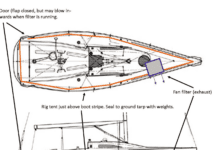A Smart, Easy Way to Rewire
Running the wires for new electronics requires your best cursing vocabulary, lots of sweat, twisting body contortions, luck, and the occasional bandage. For tips on how to make this job easier, we turned to PS contributor Bill Bishop. A professional marine-electronics installer, Bishop has many ingenious ways to thread a wire from point A to point B.
Hose Fitting Tips
Pulling hoses is generally low on the fun list. They are in bad places, jammed onto crusty hose-fitting barbs, and have stiffened over the years. As part of our 2016 update on long-term tests, we needed to wiggle loose a few of the sanitation hoses were testing to see how they were looking on the inside-a job much less pleasant than new installation.
Small Wire Connections: Best Methods
Connecting two standard-size wires is pretty straightforward: Grab a ratchet crimper, adjust it to fit the crimp connector, strip the two wires to fit into the butt connector, slide the wires into the connector, and squeeze the crimper. The required materials are readily available: butt connectors for inline splices, ring connectors for terminal blocks, and a dab of anti-corrosive grease for the bolts and rings. Done right, these connections can survive some extremely tough conditions. In a recent test of anti-corrosion greases and connections, we demonstrated how these connections can last up to five years in the worst bilge conditions.
Considering Fiber-Reinforced Composites for Sheathing
As we explore material legacies and evolution with a regenerative lens for our Wharram Narai Mk IV build, the focus now shifts to sheathing...
Seacocks for Thin Hulls
A proper below-the-water line sea cock consists of three parts: the outside portion or mushroom, which threads into the flanged valve, the flanged valve, and the backing plate.
DIY Fairing and Filling
Epoxy deserves its wonder resin status as a highly adhesive, water-resistant laminating resin. It is the secret sauce behind a shelf full of fillers, glues, and fairing compounds.
Non-Skid Refinishing with KiwiGrip
Like most sailboats from the heyday of factory production in the 70s and 80s, our 1978 Islander Bahama came with a textured non-skid gelcoat...
Wheel Thimbles for Synthetic Line Terminals
This is not a completely new concept. Spool thimbles have long been used on multi-pulley block beckets to increase the pin diameter to better...
Restoring a Classic: How to Get into Sailboat Ownership on a Budget
Some sailboat buyers want (and can afford) to plunk down a boatload of money to get on the water right away. For others, restoring...
Making Your Own Workshop Filter
It all started when I needed to make a number of large cuts inside the house and outside of the confines of my shop....




















































